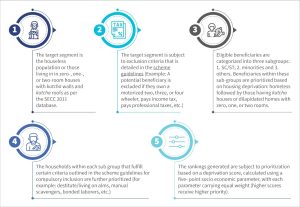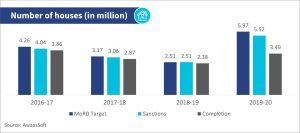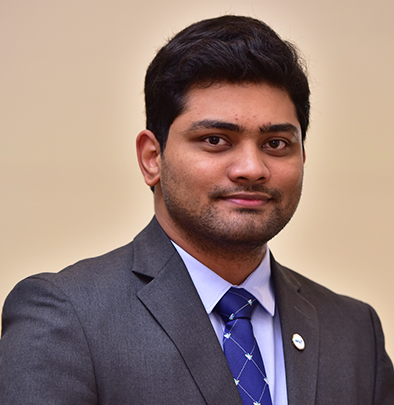PMAY-G: Transforming the rural housing program in India (Part I)
by Kushagra Harshavardhan
Apr 6, 2021
8 min
The Government of India has envisioned providing shelter to the homeless since the country gained independence. This blog talks about the evolution of various rural housing programs. It also highlights the improvements in housing provisions due to Pradhan Mantri Awaas Yojana-Gramin, an initiative of the government to provide housing for the rural poor.
This is the first part of a two-part series blog on rural housing programs in India
Majuli in the northeastern Indian state of Assam is the biggest river island in the world. Flanked by the mighty river Brahmaputra, the low-lying island is prone to flooding. The annual onslaught of floods destroys everything—from houses to paddy fields, disrupting the lives of poor villagers. In response, the government introduced “Chang Ghar” houses—structurally sound buildings raised on stilts. They have a big room, a central kitchen, and an attached toilet.
“This is sheer magic and I now have a pukka[1] house for myself with a toilet, running water, and also a gas connection,” exclaimed one villager after she received her house through the Pradhan Mantri Awaas Yojana – Grameen (PMAY-G) scheme. Many others in her village had a similar experience. PMAY-G is the central government’s program that provides affordable housing for eligible poor beneficiaries.
To understand how PMAY-G came into existence and how it has performed so far, we must look at the genesis of the rural housing programs in India.
Introduction and evolution of rural housing programs in India
After India became independent in August 1947, the young nation faced a huge housing crisis due to large-scale migration, which left many without houses or shelter. During the 1950s, the Government of India (GoI) began providing housing to rehabilitate refugees of the partition. By 1960, around half a million homes were provided across northern India.
From 1957 to 1996, the GoI implemented several rural housing schemes. In 1957, the GoI introduced the Village Housing Program (VHP), under which individuals and cooperatives availed housing loans of up to INR 5,000 (USD 70[2]). The GoI then introduced House Sites-cum-Construction Assistance Scheme (HSCAS) in 1969, under which it constructed 67,000 houses over the next 10 years.
The GoI further advanced its rural housing agenda through employment programs, such as the National Rural Employment Program (NREP, 1980) and the Rural Landless Employment Guarantee Program (RLEGP-1983). Houses were constructed under these programs for Scheduled Castes/Scheduled Tribes (SCs/STs)[3] and rescued bonded laborers.[4] Indira Awaas Yojana (IAY) was the first major attempt by the GoI to respond to the shortage in rural housing in the country by providing lump-sum monetary assistance for construction.
- Indira Awaas Yojana
The GoI launched IAY in June, 1985 as a sub-scheme under RLEGP for the construction of houses for SC, ST, and rescued bonded laborers. In January, 1996, IAY became an independent scheme and coverage was extended to Below Poverty Line (BPL)[5] households as well. Since its inception, assistance under IAY has been used to construct 36 million homes, which represents 89% of the annual target set by the GoI.[6] Although this completion rate is quite respectable, the GoI faced several challenges in the design, implementation, and monitoring of the IAY scheme. The following section outlines these challenges:[7]
- Targeting: Under the scheme, authorization to select beneficiaries from the target segment rested with gram panchayats.[8] Providing greater autonomy to local village bodies without proper monitoring resulted in the inclusion of ineligible beneficiaries. There were instances of multiple benefits being provided to the same family. The scheme did not meet the criteria regarding the allotment of 60% of the funds for the construction of houses to SC/ST and 40% to non-SC/ST below poverty line (BPL) households. Out of the houses sanctioned during 2008-09 to 2012-13, only 55% were allotted to SC/ST households.
- Baseline assessment of housing shortage: The housing shortage assessment, which determines the gap between housing required and existing availability, is of utmost importance for the scheme to be effective. Under IAY, 14 states across the country did not undertake a housing shortage assessment, which resulted in inaccurate figures for housing requirements.
- Convergence with other schemes: The scheme envisaged convergence with existing GoI programs around sanitation, clean drinking water, electricity connections, and affordable credit so that benefits under these programs could be extended to IAY beneficiaries. Convergence with these existing schemes rested with the gram panchayats. Lack of effective monitoring resulted in poor outcomes for the convergence.
- Universal house design: Under IAY, the GoI suggested a uniform house design across all geographies. The design, however, was not suited for topographical variations in the country, which reduced the longevity of the houses. The GoI also failed to provide technical assistance for the design and construction process to beneficiaries of the scheme.
Thirty-one years after its inception, IAY was not able to completely address the shortage of housing in rural India. In 2012, the rural housing gap was estimated to be approximately 40 million based on the assessment of the Working Group on Rural Housing under the XIth plan. To address the shortcomings of IAY and expedite the provision of rural housing, the GoI revamped the scheme and relaunched it as Pradhan Mantri Awaas Yojana – Gramin (PMAY-G) in 2016.
2) Pradhan Mantri Awaas Yojana – Gramin (PMAY-G)
The Ministry of Rural Development (MoRD), a Ministry under the GoI’s purview, launched PMAY-G to provide 29.5 million pukka houses, which featured basic amenities including toilets, electricity connections, and clean drinking water. The objective of the scheme was to provide such pukka houses by 2022 to all rural houseless and those living in kutcha houses[1] and in dilapidated housing. The GoI utilized the Socio Economic Caste Census (SECC 2011) to identify and select beneficiaries.
Under PMAY-G, eligible beneficiaries receive a sum of INR 120,000 (USD 1,720)[2] in multiple installments[3] to construct a house. To provide further assistance and basic necessities to the PMAY-G beneficiaries, the scheme converges with existing government programs.
PMAY-G’s convergence with Mahatma Gandhi National Rural Employment Guarantee Scheme (MGNREGS) entitles beneficiaries to 90 person-days of work on one’s own house and payment of INR 18,000 (USD 260) for such work, while convergence with the Swacch Bharat Mission – Gramin (SBM-G) entitles beneficiaries to additional assistance worth INR 12,000 (USD 170) for toilets. Convergence with Pradhan Mantri Ujjwala Yojana (PMUY) ensures cooking gas connections, the National Rural Drinking Water Program (NRDWP) ensures clean drinking water connections, while Pradhan Mantri Sahaj Bijli Har Ghar Yojana (SAUBHAGYA) ensures electricity connections to PMAY-G beneficiaries.
Besides, beneficiaries are entitled to avail of a housing loan of up to INR 70,000 (USD 1,000) from banking institutions at a rate below the prevailing rates in the market. All monetary benefits accruing to beneficiaries are transferred to their respective Aadhaar[4]-linked bank accounts through the Public Financial Management System (PFMS).
Under PMAY-G, MoRD targeted the construction of 29.5 million houses in multiple phases. During the first phase, 10 million houses were to be constructed between 2016 and 2018, and another 19.5 million in the second phase from 2019 to 2022. PMAY-G was designed to overcome the challenges that emerged under IAY. We discuss these challenges in more detail below.
Improvements over IAY
i) Scheme design
- Robust beneficiary identification and selection: The scheme emphasizes fairness and transparency in beneficiary selection. The scheme design was built on the principle of “housing for all.” Under the revamped PMAY-G scheme, beneficiaries are identified and targeted as follows:
The eligible list of beneficiaries that has been generated is verified by gram panchayats for discrepancies. This list is referred to as the permanent waitlist. Based on annual targets, housing sanctions are made based on the final rankings of beneficiaries on the waitlist.
- Implementation of e-governance: The implementation and monitoring of the scheme are carried out through an end-to-end e-governance model, consisting of AwaasSoft (MIS) and AwaasApp (mobile application). The AwaasSoft plays a pivotal role in key governance and operational functions and AwaasApp provides a mobile-friendly interface. The functions include target setting, beneficiary selection, beneficiary management, fund management, sanction management, and construction progress monitoring. The implementation of the e-governance solution has expedited the overall progress of home construction and facilitated more effective resource management.
- Convergence with other schemes: To foster better convergence outcomes, AwaasSoft is linked to the respective scheme databases for MGNREGS and SBM-G. It captures beneficiary details during registration that are utilized to transfer convergence benefits seamlessly into their respective bank accounts. Responsibility of convergence with other schemes, that is, PMUY, SAUBHAGYA, and NRDWP rests with the gram panchayats.
- Technical assistance: The National Technical Support Agency (NTSA), which was established under PMAY-G, monitors construction quality. Beneficiaries receive suggestions on housing design and the use of appropriate technology for home construction best suited to the local conditions through information, education, and communication activities. Beneficiaries also receive assistance with raw material procurement from locally available sources and cost and material estimates, as well as labor requirements.
ii) Scheme performance
- Physical progress of the scheme: The scheme has achieved 94.8% of its target[5] for the first three years. It has completed the construction of 9.11 million houses.
-
Effects on employment generation: Various research organizations have assessed the effectiveness of PMAY-G on generation of direct employment.[6] Research estimates from the National Institute of Public Finance and Policy (NIPFP) showed that since its inception on 1st April, 2016 up until 5th March, 2018, the scheme generated up to 298.4 million person-days of unskilled labor[7] and up to 213 million person-days of skilled labor[8].
PMAY-G benefitted from improvements to both design and performance when compared to its predecessors. Difficulties, however, remained around achieving targets and differential performance among states. The next blog in this series, “PMAYG: Transforming the rural housing program in India – Part II” will discuss the challenges PMAY-G faces and how addressing these challenges will facilitate the GoI’s objective of “Housing for All by 2022.”
[1] A kutcha house is a temporarily constructed shelter not made from cement. They are mostly made from brick and mud.
[2] PMAYG is funded by GoI and state governments in the ratio of 60:40, for the Northeastern states and two Himalayan states (Himachal Pradesh and Uttarakhand) the ratio of funding is 90:10. The scheme is financed wholly by GoI in the case of union territories.
[3] The installment payments are linked to level of construction. State governments have the autonomy to decide the number of installments.
[4] Aadhaar is a verifiable 12-digit unique identification number issued by the GoI to residents of India.
[5] Houses for which construction started in one year but completed in subsequent years are counted as achievement against the annual target set for the year in which construction was initiated; hence, this does not reflect actual physical completion of houses in that particular year.
[6] Impact of PMAY-G on Income and Employment, 2018
[7] Unskilled labor refers to workers who have no special training or experience. They comprise the workforce and have an extremely limited skill set.
[8] Skilled Laborers are workers who have acquired the necessary skills and training for a particular job (Example: plumber or electrician).
[1] A pukka house is one that can withstand normal wear and tear due to usage and natural forces including climatic conditions, with reasonable maintenance, for at least 30 years.
[2] Conversion rate USD 1 = INR 70
[3] Due to the iniquitous and hierarchal character of Indian society, SC/ST communities are considered as socially disadvantaged groups.
[4] Bonded labor is the pledge of a person’s services as security for the repayment of a debt or other obligation.
[5] Below Poverty Line is an economic benchmark set by the GoI to identify economically weaker people and households. It refers to a threshold income level; people whose income is below this threshold are considered poor or below poverty line.
[6] Rajya Sabha question on status of IAY, 2016
[7] Performance audit report: Indira Awaas Yojana, 2014
[8] Gram Panchayats are formalized local self-governance systems in India at the village level, which has a sarpanch as its elected head.
 by
by  Apr 6, 2021
Apr 6, 2021 8 min
8 min 


Leave comments